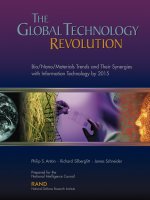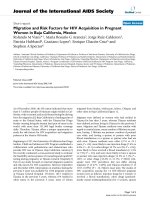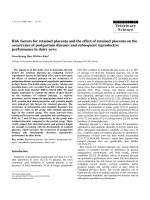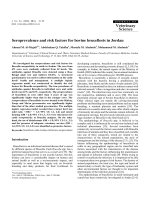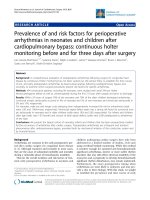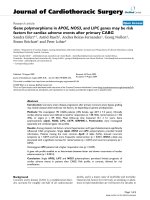Prevalence and risk factors for refractive errors and their associations with major age related eye diseases in adult singapore indians
Bạn đang xem bản rút gọn của tài liệu. Xem và tải ngay bản đầy đủ của tài liệu tại đây (11.29 MB, 376 trang )
PREVALENCE AND RISK FACTORS FOR REFRACTIVE
ERRORS AND THEIR ASSOCIATIONS WITH MAJOR
AGE-RELATED EYE DISEASES IN ADULT SINGAPORE
INDIANS
PAN CHENWEI
(B. Med, Fudan University)
A THESIS SUBMITTED
FOR THE DEGREE OF DOCTOR OF PHILOSOPHY
DEPARTMENT OF EPIDEMIOLOGY AND PUBLIC HEALTH
YONG LOO LIN SCHOOL OF MEDICINE
NATIONAL UNIVERSITY OF SINGAPORE
2012
DECLARATION
I hereby declare that the thesis is my original work and it
has been written by me in its entirety. I have duly
acknowledged all the sources of information which have
been used in the thesis.
This thesis has also not been submitted for any degree in
any university previously.
Pan Chenwei
18 October 2012
i
ACKNOWLEDGEMENTS
My heartfelt thanks go to my supervisor, Prof. Saw Seang Mei who provided superb
support, mentorship and guidance from the beginning to the end of my PhD study. I also
thank her for motivating me to continue striving for excellence. I would also like to extend
my gratitude to my co-supervisor and principal investigator of the Singapore Indian Eye
Study, Prof. Wong Tien Yin for his valuable comments, assistance and critical review of
my work. I attribute this dissertation and all the publications to the encouragement and
effort of my supervisors, without which it is impossible for me to finish this dissertation
and publish research papers.
I would also like to thank Prof Aung Tin for agreeing to be the chairman of my
Thesis Advisory Committee (TAC) and giving me valuable ideas and suggestions.
The financial support of this study from Biomedical Research Council (BMRC),
08/1/35/19/550 and National Medical Research Council (NMRC), STaR/0003/2008 is
acknowledged. In addition, I would also like to thank the National University of
Singapore for the scholarship and financial support of my PhD study.
I am grateful to all of my friends and colleagues who have helped me in any respect
of my PhD study including Dr Cheng Ching-Yu, Dr Zheng Ying-Feng, Dr Carol
Cheung and Ms Lin Xiao-Yu. In addition, the current and past clinical and
administrative staffs of the Singapore Indian Eye Study is greatly appreciated for their
hard work in recruitment and collection of clinical data, without which my thesis would
have not existed.
Finally, I thank my parents for their love in the past years of my life. I also thank
them for the understanding and support of my leaving hometown and studying overseas.
ii
TABLE OF CONTENTS
ACKNOWLEDGEMENTS…………………………………………………………… i
LIST OF TABLES……………………………………………………………………….v
LIST OF FIGURES…………………………………………………………………… ix
LIST OF PUBLICATIONS……………………………………………………………xii
LIST OF ACRONYMS……………………………………………………………… xiii
SUMMARY…………………………………………………………………………… xv
CHAPTER 1
LITERATURE REVIEW………………………………………………………………1
1.1 Natural Development of Myopia……………………………………………………1
1.2 Axial Length as an Endophenotype of Myopia…………………………………….2
1.3 Measurement of Refraction and Ocular Biometry……………………………… 2
1.4 Socioeconomic Burden of Myopia………………………………………………… 3
1.5 Prevalence of Myopia……………………………………………………………… 4
1.5.1 Worldwide Prevalence of Myopia in Adults…………………………………… 4
1.5.2 Worldwide Prevalence of Myopia in Children………………………………… 8
1.6 Major Risk Factors for Myopia……………………………………………………12
1.6.1 Outdoor Activities as a Protective Factor for Myopia…………………………12
1.6.2 Near Work as a Risk Factor for Myopia……………………………………… 14
1.6.3 Role of Education…………………………………………………………………16
1.6.4 Parental Myopia as a Risk Factor for Myopia………………………………….17
1.6.5 Myopia in Animal Models……………………………………………………… 18
1.6.6 Genetic Risk Factors for Myopia……………………………………………… 19
1.7 Axial Length……………………………………………………………………… 20
1.7.1 Axial Length and Refractive Error…………………………………………… 20
1.7.2 Mean Axial Length in Population-Based Studies………………………………21
1.7.3 Axial Length and Ocular Biometric Components…………………………… 22
1.8 Migration Studies on Myopia…………………………………………………… 22
1.9 Refractive Error and Major Age-Related Eye Diseases………………………….24
1.9.1 Refractive Error and Age-Related Macular Degeneration…………………….24
1.9.2 Refractive Error and Diabetic Retinopathy…………………………………….25
iii
1.9.3 Refractive Error and Age-Related Cataract……………………………………25
1.9.4 Refractive Error and Primary Open Angle Glaucoma…………………………26
1.10 Summary of the Literature Review………………………………………………28
CHAPTER 2
AIMS AND OBJECTIVES OF THESIS………………………………………………31
CHAPTER 3
METHODS…………………………………………………………………………… 32
3.1 Study Design……………………………………………………………………… 32
3.2 Sampling Frame…………………………………………………………………….32
3.3 Sample Size Calculation……………………………………………………………33
3.4 Recruitment Strategies…………………………………………………………… 34
3.5 Clinical Examinations………………………………………………………………34
3.6 Questionnaire and Interview………………………………………………………38
3.7 Definition of Immigrant Status…………………………………………………….39
3.8 Disease Definitions………………………………………………………………….39
3.8.1 Refractive Error………………………………………………………………… 39
3.8.2 Age-Related Macular Degeneration…………………………………………… 40
3.8.3 Diabetic Retinopathy…………………………………………………………… 41
3.8.4 Age-Related Cataract…………………………………………………………….41
3.8.5 Glaucoma………………………………………………………………………….42
3.9 Data Management and Quality Control………………………………………… 42
3.10 Statistical Analyses……………………………………………………………… 43
CHAPTER 4
RESULTS……………………………………………………………………………….49
4.1 Characteristics and Demographics of the Study Population…………………… 49
4.2 Prevalence and Risk Factors for Refractive Errors………………………………50
4.3 Axial Length and Other Ocular Biometric Parameters………………………… 54
4.4 Myopia Prevalence and Axial Length in the First and Second (or higher)
Generation Immigrants……………………………………………………………… 58
4.5 Refractive Error, Axial Length and Major Age-Related Eye Diseases…………62
4.6 Meta-Analysis of the Association between Refractive Error and Age-Related
iv
Macular Degeneration………………………………………………………………….67
CHAPTER 5
DISCUSSION………………………………………………………………………… 69
5.1 Important Findings of the Study………………………………………………… 69
5.2 Novelty of the Study……………………………………………………………… 69
5.3 Patterns of Refractive Error and Ocular Biometry………………………………70
5.4 Effect of Migration and Acculturation on Myopia and Axial Length………… 79
5.5 Protective Effect of Myopia and Longer Axial Length for Age-Related Macular
Degeneration and Diabetic Retinopathy………………………………………………82
5.6 Associations of Refractive Error and Axial Length with Age-Related Cataract
and Primary Open Angle Glaucoma………………………………………………….86
5.7 Strengths and Limitations………………………………………………………….88
5.8 Implications of the Study………………………………………………………… 90
BIBLIOGRAPHY…………………………………………………………………… 93
APPENDICES…………………………………………………………………………249
v
LIST OF TABLES
Table 1. Prevalence of Myopia in Adults in Population-Based Studies……………107
Table 2. Prevalence of Myopia in Children in Population-Based Studies…………109
Table 3. Age-Specific Prevalence of Myopia in Children………………………… 111
Table 4. More Outdoor Time as a Protective Factor for Myopia………………….117
Table 5. Near Work as a Risk Factor for Myopia………………………………… 119
Table 6. Parental Myopia as a Risk Factor for Myopia…………………………….122
Table 7. The Associations of Refractive Errors with Age-Related Macular
Degeneration………………………………………………………………………… 124
Table 8. The Association of Myopia with Diabetic Retinopathy………………… 126
Table 9. The Association of Myopia with Age-Related Cataract………………… 127
Table 10. The Association of Myopia with Open Angle Glaucoma……………… 128
Table 11. Characteristics of the Study Population by Gender and Age………… 132
Table 12. Characteristics of the Study Population by Educational Level and
Socioeconomic Status………………………………………………………………….133
Table 13. Characteristics of the Study Population with and without Cataract
Surgery…………………………………………………………………………………135
Table 14. Comparison of Subjects Included in and Excluded from Refraction Data
Analyses……………………………………………………………………………… 136
Table 15. Prevalence of Myopia and High Myopia in the Singapore Indian Eye
Study………………………………………………………………………………… 138
Table 16. Mean Spherical Equivalent by Age and Gender…………………………140
Table 17. Nuclear Cataract-Specific Prevalence of Myopia within Each Age Group
………………………………………………………………………………………… 141
Table 18. Age-Specific Prevalence of Myopia by Nuclear Opacity Score…………142
Table 19. Prevalence of Astigmatism, Hyperopia and Anisometropia in the
Singapore Indian Eye Study………………………………………………………….143
Table 20. Mean Spherical Equivalent by Potential Risk Factors for Myopia…… 145
Table 21. Multiple Logistic Regression Models of the Risk Factors Associated with
Refractive Errors…………………………………………………………………… 148
Table 22. Prevalence of Myopia (spherical equivalent < -0.5D) Stratified by Lens
vi
Opacity Classification System III Grade in Andhra Pradesh Eye Disease Study and
Singapore Indian Eye Study………………………………………………………….149
Table 23. Means of Ocular Biometric Parameters by Age and Gender in the
Singapore Indian Eye Study………………………………………………………….150
Table 24. Median and Distribution of Ocular Biometric Parameters in the
Singapore Indian Eye Study………………………………………………………….151
Table 25. Mean Ocular Biometric Parameters by Potential Determinants……….153
Table 26. Multivariate Analysis on the Determinants of Ocular Biometric
Parameters…………………………………………………………………………….158
Table 27. Correlation of Ocular Biometric Parameters and Spherical Equivalent by
Refractive Status………………………………………………………………………159
Table 28. Multivariable Linear Regression Models for Spherical Equivalent
Refraction, by Axial Length, Corneal Curvature, Axial Length / Corneal Curvature
ratio and Nuclear Opacity (LOCS III) Stratified by Age………………………….160
Table 29. Mean Axial Length and Spherical Equivalent in Adults 40-49 Years of
Age in Different Population-Based Studies…………………………………………163
Table 30. Characteristics of the First and Second (or Higher) Generation Indian
Immigrants Living in Singapore…………………………………………………….164
Table 31. Prevalence of Myopia, High Myopia, Mean Spherical Equivalent, Axial
Length, Anterior Chamber Depth and Corneal Radius of Curvature between
Different Generation Immigrants……………………………………………………165
Table 32. Effect of Potential Explanatory Factors on the Excess Prevalence of
Myopia and High Myopia in Second (or higher) Generation Immigrants Compared
with First Generation Immigrants………………………………………………… 166
Table 33. Prevalence of Myopia, Mean Axial Length and Spherical Equivalent by
Age at Migration among the First Generation Immigrants……………………… 167
Table 34. Associations of Age at Migration with the Prevalence of Myopia
(Spherical Equivalent <-0.5D), Spherical Equivalent and Axial Length in First
Generation Immigrants………………………………………………………………168
Table 35. Associations of Age at Migration with the Prevalence of Myopia
(Spherical Equivalent <-0.5D), Spherical Equivalent and Axial Length for the
vii
Whole Study Participants………………………………………………………… 169
Table 36. Associations of Interview Language with Myopia (Spherical Equivalent
<-0.5D), Spherical Equivalent and Axial Length in Migrant Indians Living in
Singapore………………………………………………………………………………170
Table 37. Risk Factors for Myopia among the First and Second (higher) Generation
Immigrants…………………………………………………………………………….171
Table 38. Characteristics of Included Participants with and without any
Age-Related Macular Degeneration………………………………………………….172
Table 39. Associations of Refractive Error and Axial Length with Age-Related
Macular Degeneration or Specific Age-Related Macular Degeneration Signs……173
Table 40. Associations of Severity of Myopia with AMD or Specific AMD Signs 174
Table 41. Characteristics of Included Diabetic Participants with and without any
Retinopathy……………………………………………………………………………175
Table 42. Associations of Refractive Error and Axial Length with Diabetic
Retinopathy or Vision-threatening Diabetic Retinopathy………………………….176
Table 43. Associations of Severity of Myopia with Diabetic Retinopathy or
Vision-threatening Diabetic Retinopathy……………………………………………177
Table 44. Characteristics of Included Participants with and without any
Age-Related Cataract…………………………………………………………………178
Table 45. Associations of Refractive Error and Axial Length with Age-Related
Cataract……………………………………………………………………………… 179
Table 46. Associations of Severity of Myopia with Age-Related Cataract……… 180
Table 47. Characteristics of Participants With and Without any Primary Open
Angle Glaucoma……………………………………………………………………….181
Table 48. Age and Gender Adjusted Mean Spherical Equivalent, Axial Length,
Corneal Curvature, Anterior Chamber Depth, Central Corneal Thickness and
Intraocular Pressure in Eyes with and without Any Primary Open Angle
Glaucoma………………………………………………………………………………182
Table 49. Age and Gender Adjusted Associations of Central Corneal Thickness and
Intraocular Pressure with Myopia or Axial Length……………………………… 183
Table 50. Associations of Refractive Error and Axial Length with Primary Open
viii
Angle Glaucoma……………………………………………………………………….184
Table 51. Associations of Severity of Myopia with Primary Open Angle
Glaucoma………………………………………………………………………………185
Table 52. Association of Spherical Equivalent and Axial Length with Primary Open
Angle Glaucoma in High Intraocular Pressure and Normal Intraocular Pressure
Groups…………………………………………………………………………………186
Table 53. Combined Effect of Myopia and Intraocular Pressure on Primary Open
Angle Glaucoma……………………………………………………………………….187
Table 54. Difference in Mean Refraction between Eyes with and without Ocular
Disease, Adjusted for Axial Length………………………………………………… 188
Table 55. Pooled Estimates on the Associations of Refractive Error and Age-related
Macular Degeneration……………………………………………………………… 190
ix
LIST OF FIGURES
Figure 1. Formation and Correction of Myopia…………………………………….191
Figure 2. Urban versus Rural Differences in Myopia Prevalence in the Refractive
Error Study in Children………………………………………………………………192
Figure 3. Forest Plot of Risk Estimates of the Association between any Myopia and
Open-Angle Glaucoma……………………………………………………………… 193
Figure 4. Forest Plot of Risk Estimates of the Association between Low Myopia and
Open-Angle Glaucoma……………………………………………………………… 194
Figure 5. Forest Plot of Risk Estimates of the Association between High Myopia and
Open-Angle Glaucoma……………………………………………………………… 195
Figure 6. Study Area for the Singapore Indian Eye Study…………………………196
Figure 7. Sampling Frame of the Singapore Indian Eye Study…………………….197
Figure 8. Examination Flowchart for the Singapore Indian Eye Study………… 198
Figure 9. Final Response for the Singapore Indian Eye Study…………………… 199
Figure 10. Age and Gender Distribution of the Singapore Indian Eye Study…….200
Figure 11. Educational Level in the Singapore Indian Eye Study…………………201
Figure 12. Housing Type in the Singapore Indian Eye Study…………………… 202
Figure 13. Individual Monthly Income in the Singapore Indian Eye Study………203
Figure 14. Smoking Categories in the Singapore Indian Eye Study……………….204
Figure 15. Distribution of Height and Weight in the Singapore Indian Eye Study.205
Figure 16. Distribution of Blood Pressure in the Singapore Indian Eye Study… 206
Figure 17. Distribution of Intraocular Pressure in the Singapore Indian Eye
Study………………………………………………………………………………… 207
Figure 18. Distribution of Cup Disc Ratio in the Singapore Indian Eye Study… 208
Figure 19. Distribution of Central Cornea Thickness in the Singapore Indian Eye
Study………………………………………………………………………………… 209
Figure 20. Distribution of Hypertension in the Singapore Indian Eye Study…… 210
Figure 21. Distribution of Diabetes in the Singapore Indian Eye Study………… 211
Figure 22. Distribution of Spherical Equivalents in the Right Eye by Age Group in
Indian Residents in Singapore……………………………………………………… 212
Figure 23. Box Plot of Spherical Equivalent by Age Groups………………………213
x
Figure 24. Prevalence of Myopia by Educational Level……………………………214
Figure 25. Line Graphs of Prevalence of Myopia by Age for Those with (n = 323),
without Nuclear Cataract, and All Adults………………………………………… 215
Figure 26. Line Graphs of Prevalence of Myopia by Age in Andhra Pradesh Eye
Disease Study, Chennai Glaucoma Study and Singapore Indian Eye Study…… 216
Figure 27. Prevalence of Myopia in the Tanjong Pagar Survey, Singapore Malay
Eye Study and Singapore Indian Eye Study in Men……………………………… 217
Figure 28. Prevalence of Myopia in the Tanjong Pagar Survey, Singapore Malay
Eye Study and Singapore Indian Eye Study in Women…………………………….218
Figure 29. Distribution of Axial Length in the Singapore Indian Eye Study…… 219
Figure 30. Distribution of Axial Lengths by Age Groups………………………… 220
Figure 31. Distribution of Anterior Chamber Depth in the Singapore Indian Eye
Study………………………………………………………………………………… 221
Figure 32. Distribution of Corneal Curvature in the Singapore Indian Eye
Study………………………………………………………………………………… 222
Figure 33. LOWESS Plot on the Association between Axial Length and Spherical
Equivalent…………………………………………………………………………… 223
Figure 34. LOWESS Plot on the Association between Axial Length/Corneal
Curvature Ratio and Spherical Equivalent…………………………………………224
Figure 35. LOWESS Plot on the Association between Anterior Chamber Depth and
Spherical Equivalent………………………………………………………………….225
Figure 36. LOWESS Plot on the Association between Corneal Curvature and
Spherical Equivalent………………………………………………………………….226
Figure 37. Box Plot of Axial Length by Spherical Equivalent Groups……………227
Figure 38. Box Plot of Anterior Chamber Depth by Spherical Equivalent
Groups…………………………………………………………………………………228
Figure 39. Box Plot of Corneal Curvature by Spherical Equivalent Groups…… 229
Figure 40. Box Plot of Axial Length / Corneal Curvature Ratio by Spherical
Equivalent Groups……………………………………………………………………230
Figure 41. Height-Adjusted Axial Length by Age and Gender…………………….231
Figure 42. Association between Axial Length and Spherical Equivalent in Adults
xi
with and without Nuclear Cataract………………………………………………….232
Figure 43. Correlations between Axial Length and Corneal Radius by Refractive
Status………………………………………………………………………………… 233
Figure 44. Distribution of Birth Place……………………………………………… 234
Figure 45. Distribution of Age at Migration among the First Generation
Immigrants…………………………………………………………………………….235
Figure 46. Associations of Axial Length and Age at Migration…………………….236
Figure 47. Distribution of Age-Related Macular Degeneration……………………237
Figure 48. Distribution of Diabetic Retinopathy…………………………………….238
Figure 49. Distribution of Nuclear Cataract……………………………………… 239
Figure 50. Distribution of Cortical Cataract……………………………………… 240
Figure 51. Distribution of Posterior Subcapsular Cataract……………………… 241
Figure 52. Distribution of Primary Open Angle Glaucoma……………………… 242
Figure 53. LOWESS Plot of the Relationship between Spherical Equivalent and
Prevalence of Primary Open Angle Glaucoma…………………………………… 243
Figure 54. LOWESS Plot of the Relationship between Axial Length and Prevalence
of Primary Open Angle Glaucoma………………………………………………… 244
Figure 55. Forest Plot of Risk Estimates of the Association between Hyperopia and
Prevalent Age-Related Macular Degeneration…………………………………… 245
Figure 56. Forest Plot of Risk Estimates of the Association between Myopia and
Prevalent Age-Related Macular Degeneration…………………………………… 246
Figure 57. Forest Plot of Risk Estimates of the Association between Hyperopia and
Incident Age-Related Macular Degeneration……………………………………… 247
Figure 58. Forest Plot of Risk Estimates of the Association between Myopia and
Incident Age-Related Macular Degeneration……………………………………… 248
xii
LIST OF PUBLICATIONS
1. Pan CW, Ramamurthy D, Saw SM. Worldwide prevalence and risk factors for myopia.
Ophthalmic Physiol Opt. 2012 Jan;32(1):3-16.
2. Pan CW, Wong TY, Lavanya R, Wu RY, Zheng YF, Lin XY, Mitchell P, Aung
T, Saw SM. Prevalence and risk factors for refractive errors in Indians: the
Singapore Indian Eye Study (SINDI). Invest Ophthalmol Vis Sci. 2011 May
16;52(6):3166-73.
3. Pan CW, Wong TY, Chang L, Lin XY, Lavanya R, Zheng YF, Kok YO, Wu
RY, Aung T, Saw SM. Ocular biometry in an urban Indian population: the
Singapore Indian Eye Study (SINDI). Invest Ophthalmol Vis Sci. 2011 Aug
22;52(9):6636-42.
4. Pan CW, Zheng YF, Wong TY, Lavanya R, Wu RY, Zheng YF, Gazzard G, Saw SM.
Variation in prevalence of myopia between generations of migrant Indians living in
Singapore. Am J Ophthalmol. [Epub ahead of press, 2012]
5. Pan CW, Cheung C, Aung T, Cheung CM, Zheng YF, Wu RY, Mttchell P, Lavanya R,
Baskaran M, Wang JJ, Wong TY, Saw SM. Differential associations of myopia with
major age-related eye diseases: the Singapore Indian Eye Study. Ophthalmology 2012
6. Pan CW, Ikram MK, Cheung C, Choi HW, Cheung CM, Jonas JB, Saw SM, Wong
TY. Refractive errors and age-related macular degeneration: a systematic review and
meta-analysis. Ophthalmology (Under review)
xiii
LIST OF ACRONYMS
D
diopters
SE
spherical equivalent
AL
axial length
GWAS
genome-wide association study
ACD
anterior chamber depth
LT
lens thickness
NHANES
National Health and Nutrition Examination Survey
CI
confidence interval
PAR%
population attributable risk percentage
RESC
Refractive Error Study in Children
SCORM
Singapore Cohort Study of Risk factors for Myopia
STARS
Strabismus, Amblyopia and Refractive error Study in Singapore
Preschool Children
SMS
Sydney Myopia Study
OLSM
Orinda Longitudinal Study of Myopia
CLEERE
Collaborative Longitudinal Evaluation of Ethnicity and Refractive Error
OR
odds ratio
ECM
extracellular matrix
CR
corneal radius of curvature
VCD
vitreous chamber depth
AMD
Age-Related Macular Degeneration
DR
Diabetic Retinopathy
WESDR
Wisconsin Epidemiologic Study of Diabetic Retinopathy
PSC
posterior subcapsular cataract
POAG
Primary Open Angle Glaucoma
IOP
intraocular pressure
CCT
central corneal thickness
SERI
Singapore Eye Research Institute
IRB
Institutional Review Board
HDL
high density lipoprotein cholesterol
LDL
low density lipoprotein cholesterol
HbA1c
hemoglobin A1c
HPLC
high-performance liquid chromatography
RPE
retinal pigment epithelium
NPDR
non-proliferative diabetic retinopathy
PDR
proliferative diabetic retinopathy
CSME
clinically significant macular edema
VTDR
vision-threatening diabetic retinopathy
LOCS III
Lens Opacity Classification System III system
CDR
cup-disc ratio
GEE
generalized estimating equation
HR
hazards ratios
IQR
inter quartile range
xiv
BMI
body mass index
SINDI
Singapore Indian Eye Study
SiMES
Singapore Malay Eye Study
HLA
human leukocyte antigen
xv
SUMMARY
Myopia is a global public health concern and there may be an epidemic of myopia
in Singapore. Current data revealed racial differences in myopia prevalence even after
adjusting for education, suggesting that other factors, including genetic factors, may be
responsible for the racial variation. Detailed inter-ethnic comparisons among middle-aged
and elderly Indians, Chinese and Malays in Singapore have not been conducted. The
prevalence of myopia among Indian adults in Singapore may be different from Indian
adults in India. Possible ocular complications of myopia including cataract, age-related
macular degeneration (AMD), diabetic retinopathy (DR) and primary open angle
glaucoma (POAG) have been reported in Caucasians and Chinese, and should be
carefully delineated in Indians.
Population-based cross-sectional data in the Singapore Indian Eye Study on
Indians aged 40-84 years were analyzed in this study. The overall aim of the thesis is to
determine the prevalence and patterns of myopia and other refractive errors and theirs
associations with major age-related eye diseases in adult Singapore Indians. The aims
include: i) To determine the prevalence and risk factors for refractive errors in
middle-aged to elderly Singaporeans of Indian ethnicity, ii) To describe the distribution
and determinants of ocular biometric parameters in adult Singapore Indians, iii) To assess
the influence of factors related to migration and acculturation on myopia in migrant
Indians in Singapore. iv) To determine the associations of myopia and axial length (AL)
with major age-related eye diseases including AMD, DR, age-related cataract and POAG.
v) To determine the associations between refractive errors and AMD by a systematic
review and meta-analysis of observational studies
xvi
In this study, 28.0% of Singaporeans of Indian ethnicity aged over 40 years had
myopia, which is similar to that of Singapore Malays but lower than Singapore Chinese
of the same age. The higher myopia prevalence rates recorded among Indians in India
compared with Singaporean Indians may be due to the high nuclear cataract rates in older
adults in India. The prevalence of myopia decreased with age in adults without nuclear
cataract and increased with age in adults with nuclear cataract, suggesting that the
U-shape curve may be explained by differences in patterns for adults with and without
nuclear cataract. A more myopic refraction was predominately explained by longer AL or
greater AL/corneal radius (CR) ratio throughout the whole age range, although lens
nuclear opacity was also a predictor of refraction in older age groups. Height, time spent
reading and educational level were the most important predictors of AL. Myopia was
more prevalent and ALs were longer among second (or higher) generation immigrants
compared with first generation immigrants. Among first generation immigrants, those
who migrated to Singapore at an early age and those who preferred to be and were
interviewed in English were more likely to be myopic than their counterparts. Myopic
eyes were less likely to have AMD and DR, but more likely to have nuclear cataract,
posterior subcapsular cataract and POAG. In addition, the variation in AL explained most
of the associations of refractive error with AMD, DR or POAG, but not the associations
with age-related nuclear cataract, which results from changes in the refractive power of
the lens associated with nuclear cataract.
1
CHAPTER 1
LITERATURE REVIEW
1.1 Nature Development of Myopia
Myopia is the most common eye disorder.
1
It refers to the state of refraction in
which parallel rays of light are brought to focus in front of the retina of a resting eye.
2-3
In
myopic eyes, the images of distant objects are focused in front of the retina when the
accommodation system is relaxed. Therefore, light entering the eye has to originate from
near objects in order to be focused on the retina of the myopic eye. (Figure 1) It is
measured by the spherical power in diopters (D) of the diverging lens needed to focus
light onto the retina, which can be expressed as the spherical equivalent (SE). Most
commonly used definitions of myopia in epidemiologic studies include SE of at least
-0.50 D, -0.75 D, and -1.00 D.
4
Myopia is generally classified as high myopia when it
exceeds 6 D.
3
Most infants are usually born hyperopic.
5
Normally, the eyes shift from
neonatal hypeopia to emmetropia in the first year of life.
6
Myopia typically develops
during the school years, progressing until adulthood though sometimes it may also
develop in adults. Progression typically ceases in the teenage years. Generally, the annual
progression is close to -0.50D for children aged 8 to 12 years.
7
Investigators found that
the final refractive status is correlated with the age of onset in adulthood, that is, children
who become myopic at an earlier age may have a higher risk for myopia progression and
higher degree of myopia later on.
7-8
Later in life of age over 60 years, a myopic refractive
shift may result from crystalline lens changes.
9
2
1.2 Axial Length as an Endophenotype of Myopia
Axial Length (AL) is considered as an endophenotype of myopia. Both AL and
myopia can be analyzed as a quantitative trait using linkage studies. However, AL is
much more suitable. The phenotype of myopia, especially high myopia, is commonly
accompanied with other eye disorders such as cataract, glaucoma and chorioretinal
abnormalities, thus would inevitably involve some confounders and may lead to biased
conclusions. However, AL, as a clean trait, could be studied in general optical healthy
populations and subjects with low myopia to avoid those confounders. Some reported
that the heritability of myopia varies significantly among studies with different family
structures, while the heritability of AL remains quite consistent
10
. Thus, using AL as an
endophenotype could avoid or minimize the substantial bias caused by a more complex
myopic trait due to instability of heritability. AL as a clean and simple endophenotype
may bring some advantages to the research field of myopia. This conclusion was partly
supported by the first genome-wide association study (GWAS) on myopia.
11
1.3 Measurement of Refraction and Ocular Biometry.
It was suggested that subjective refraction using a phoroptor is usually preferred in
cooperative patients. Subjective refraction data were preferred for analysis since the
reproducibility of subjective refraction has been found to be within 0.50 D for spherical
equivalent, sphere power, and cylinder power.
12-13
Auto-refraction is adequate for a
preliminary refraction but is not a good substitute for subjective refraction.
12
Cycloplegic
auto-refraction is the gold standard technique for refractive error measurement.
14
Non-cycloplegic refraction might have overestimated the myopia rates, but this effect
seems to be marginal on subjects were middle-aged to elderly adults over 40 years who
3
may have lower amplitude of accommodation.
15-16
In previous studies
17-20
, AL was measured by A-scan ultrasound biometry which
requires corneal surface contact and the measurement is more time-consuming. The
non-contact optical biometry measurement which uses partial coherence interferometry
technology (IOL Master) eliminates the deficiency of A-scan ultrasound measurement. It
was suggested that the IOL Master is a better predictor of normative ocular biometric data
than ultrasound biometry.
21
Biometry data from ultrasound and laser interferometry may
be slightly different.
22
Anterior chamber depth (ACD) using ultrasound were found to be
significantly shorter than non-contact measures.
23
Compared with A-scan ultrasound,
IOL Master could either overestimate
24
or underestimate
25
AL. IOL Master also does not
provide lens thickness (LT) measurement.
1.4 Socioeconomic Burden of Myopia
Myopia is a significant public health problem and its rapid increase in prevalence
in recent decades is associated with a significant financial burden. Direct myopia related
cost includes prescription of spectacles and contact lenses, contact lenses solutions and
repeat optometry visits.
26
In Singapore, the mean annual direct cost of myopia for each
Singaporean school children aged 7 to 9 years was estimated to be US$148.
27
In the
United States, the National Health and Nutrition Examination Survey (NHANES)
reported the annual direct cost of correcting distance vision impairment due to refractive
errors to be between US$3.9 billion and US$7.2 billion.
28
Globally, the annual cost for
myopia was estimated to be US$4.6 billion in 1990.
29
There are also medical cost
associated with treating myopia induced morbidities such as retinal detachment,
4
glaucoma, cataract, and associated visual disability and blindness.
26
1.5 Prevalence of Myopia
1.5.1 Worldwide Prevalence of Myopia in Adults
In mainland China, the prevalence of myopia for definitions of SE of <-0.50 D,
<-1.0 D, <-6.0 D, and <-8.0 D were reported to be 22.9% (95% confidence interval [CI],
21.7, 24.2), 16.9% (95% CI, 15.8, 18.0), 2.6% (95% CI, 2.2, 3.1), and 1.5% (95% CI, 1.1,
1.9) respectively, in the Beijing Eye Study (n=4,439, aged 40-90 years).
30
The limitation
of this study is that refraction was not performed on subjects with an uncorrected visual
acuity of 0.0 logMAR (Snellen 6/6) or better. The Shihpai Eye study in Taiwanese adults
aged over 65 years reported the prevalence to be 19.4% and 14.5% for myopia of
SE<-0.5 D and SE <-1.0 D, respectively. The prevalence of myopia in Taiwan seems to
be lower than that of Beijing Eye Study. The difference in prevalence of less than 3.5%
between Taiwan and Beijing is marginal. This difference in prevalence is attributed to the
older sample in Taiwan leading to a hyperopic shift in refraction, but this difference in
age would also work in the opposite direction with a potential myopic shift due to the
onset of nuclear cataract in the older population.
31
In Japanese adults aged over 40 years,
the prevalence was reported to be 41.8% for myopia of SE < -0.5D.
32
The Japanese study
may have overestimated the prevalence of myopia due to younger participants and
non-cycloplegic refraction.
In India, three population-based studies have been conducted to estimate the
prevalence of myopia.
33-35
The prevalence of myopia for SE < -0.5D in 40 year and older
Indian adults in both urban and rural areas was reported to be 34.6% (n=3,723) in the
5
Indian state of Andhra Pradesh, with a prevalence of 38.0% in rural areas and 31.9% in
urban areas. The higher prevalence of myopia in the rural Indian population could be
explained by higher rates of nuclear cataract in rural India leading to a myopic shift in
refraction.
33
This study was the first to provide the population attributable risk percentage
(PAR%) data on different types of refractive errors in adult Asians. Data from this
population-based study demonstrated the expected association between age and different
types of refractive errors. In another study of rural Indian adults aged over 39 year in
Chennai (n=2,508), the prevalence was reported to be 31% for myopia of SE< -0.5D.
34
The association between myopia and age almost disappeared after adjustment for nuclear
sclerosis, indicating that nuclear sclerosis is responsible for the increase in myopia with
age. The extent of non-participation bias cannot be elucidated as neither of the studies in
India revealed details about the respondents and non-respondents. In the Central India
Eye and Medical Study, which included 4711 subjects (aged 30 years or older) of 5885
eligible subjects, myopia of more than -0.50 D, -1.0 D, more than -6.0 D, and more than
-8 D occurred in 17.0%, 13.0%, 0.9%, and 0.4% of the subjects, respectively.
35
This study
demonstrated that the rural population of Central India has not experienced a myopic
shift as described for many urban populations at the Pacific Rim.
In Bangladesh and Pakistani adults aged over 30 years, the prevalence of myopia
(SE < -0.5D) has been reported to be 23.8% (n=11,624) and 36.5% (n=14,490)
respectively whereas it is about 48.1% in Indonesian young adults aged over 21 years
(n=1,043).
36-38
The prevalence of myopia in Mongolian adults over 40 years was reported
to be 17.2% (n=1,617).
20
In the WHO National Blindness and Low Vision Surveys in
Bangladesh, non-cycloplegic refraction and subjective refraction were only performed on
6
those with visual acuity worse than 0.30 logMAR (Snellen 6/12). Thus, the prevalence of
myopia may have been overestimated.
The Tanjong Pagar Survey (TPS) and the Singapore Malay Eyes Study (SiMES)
analyzed the prevalence of myopia of SE < -0.50D in Singaporean Chinese and Malay
adults aged over 40 years and reported it to be 38.7%
39
and 26.2%
40
, respectively.
In the United States, the 1999-2004 NHANES used an autorefractor to measure
refractive data on a US non-institutionalized, civilian population aged 20 years or older.
The age-standardized prevalence of myopia (SE <−1.0 D or less) was 33.1% (95% CI,
31.5% to 34.7%) in 12,010 participants.
41
In this study, non-cycloplegic refraction may
have caused an overestimation of myopic persons among younger participants. In the
Baltimore Eye Survey (n=5,028), the prevalence of myopia (SE < -0.5D) was 28.1%
among the white and 19.4% among the black.
42
The Los Angeles Latino Eye Study
reported a myopia prevalence of 16.8% in 40 years or older adults (n=5,927) in the worse
eye.
43
In the Beaver Dam Eye Study, the age-gender adjusted prevalence of myopia (SE <
-0.5D) was 26.2% based on the data of the right eye.
44
The Barbados Eye Study
examined the prevalence of myopia in African–Americans aged 40 to 84 years (n=4,709).
The age-gender adjusted prevalence of myopia (SE<-0.5D) was 21.9% (95 CI, 20.6-23.2)
based on objective refraction data.
45
The Beaver Dam Eye study of adults aged over 43
years may have overestimated the prevalence of myopia in terms of the younger
respondents. On the contrary, the NHANES on people aged over 20 years may have
underestimated the prevalence of myopia since the younger working adults were more
difficult to recruit than the older ones.
In the UK, among a total of 2,487 randomly selected 44-year-old members of the
7
1958 British birth cohort, 1214 individuals (49%; 95% CI, 48.8-50.8) were myopic.
Refraction was measured by autorefraction using the Nikon Retinomax 2 (Nikon Corp.,
Tokyo, Japan), under non-cycloplegic conditions. Thus, myopia prevalence may have
been overestimated.
46
In Norway, non-cycloplegic refraction was measured in a
population-based sample of young (20-25 years) and middle-aged (40-45 years) adults. A
total of 3,137 persons (1,248 young and 1,889 middle-aged adults) with corrected visual
acuity worse than 0.3 logMAR (Snellen 6/12) in either eye were included in the study.
The prevalence of myopia (SE < -0.5D) was 35.0% in the young adult group and 30.3%
in the middle-aged group. Prevalence of myopia was overestimated especially for the
young adult group due to the non-cycloplegic refraction.
47
In Australia, the Blue Mountains Study reported a prevalence of myopia in adults
aged 40-97 years of 15.0% (n=3,654).
48
The Visual Impairment Project reported a
myopia (SE < −0.5 D) prevalence of 17.0% (95% CI 15.8, 18.0).
49
A meta-analysis by the
Eye Diseases Prevalence Research Group estimated the crude prevalence rates for
myopia of −1.0 D or less as 25.4%, 26.6%, and 16.4% in the United States, Western
Europe and Australia, respectively.
50
Based on the published data of myopia prevalence on adults, it is still unclear
whether the myopia prevalence is higher in East Asian Countries than in Western
Countries. The prevalence of myopia is 38.7% in Singaporean Chinese (SE < -0.5 D).
39
However, the meta-analysis by Kempen et al. showed that the prevalence of myopia is
25.4% and 26.6% for White subjects in the United States and Western Europe using a
more conservative definition of myopia (SE < -1.0 D), respectively.
50
The cut off used to
define myopia is arbitrary but the prevalence might change significantly by a small shift
